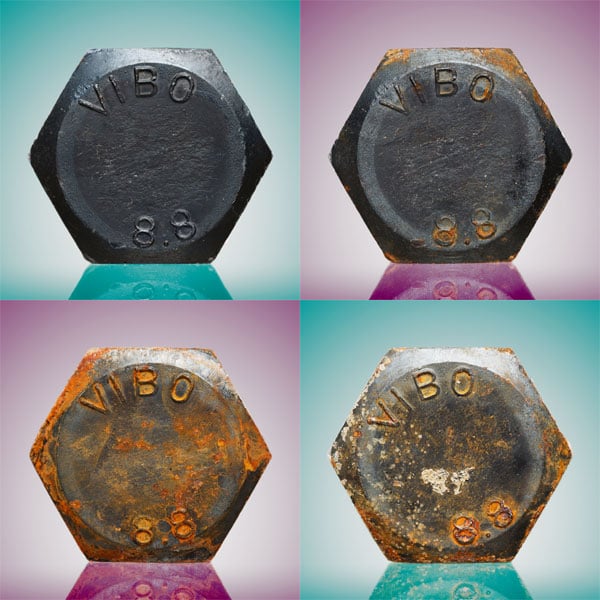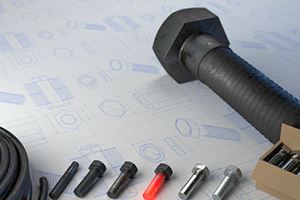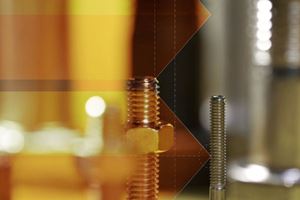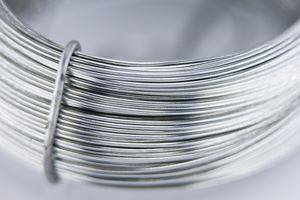Combating corrosion
If you thought corrosion was merely about unsightly patches of red oxide – rust – which plague steel and iron products in coastal areas and offshore applications, think again. Corrosion is present everywhere and can occur in even the most arid land-locked countries. It’s also a case of prevention being better than cure as corrosion can be delayed but never prevented.
Any metal product – especially those derived from iron or steel – will eventually rust and disintegrate over time when coming into contact with oxygen and water.
There are two types of reaction during corrosion: oxidation, whereby electrons leave the metal and the metal, becomes corroded, and reduction, where the electrons convert water or oxygen into hydroxides. Rust forms when the hydroxide and ferrous ions combine. As the metal corrodes, its surface changes and, in ferrous metals, rust spreads across the entire surface of the metal.

Coastal and offshore applications rust more easily than other applications due to their exposure to saltwater, which is pH neutral or slightly acidic. Products close to the shore are subject to atmospheric salinity as well as the tidal saltwater spray, which leaves a surface residue. Atmospheric salt levels are also higher the closer you get to the equator.
However, corrosion is not just limited to exposure to saltwater. Cleaning agents, high humidity and ‘dirty’ environments like sewage and mining, all exacerbate the corrosion process. Chemical process environments – rich in carbon dioxide – are also tough on metals.
Eva Coronado is Corrosion Laboratory Manager at Element Materials Technology in Houston, Texas.
“Corrosion is a natural phenomenon which occurs under certain moisture, temperature and atmospheric conditions; it cannot be avoided, only mitigated,” she explains. “Corrosion weakens products thus affecting their function and integrity. Besides having a high economic cost, corrosion impacts safety and affects the aesthetic appearance of the product.”
Former President of NACE International, the Corrosion Society – the world’s largest authority on corrosion with 30,000 members worldwide – Kevin Garrity, has spent most of his 38-year career in the field of corrosion engineering. “I started out as an electrical engineer but became intrigued by the fact that corrosion takes in so many different facets of engineering – stress, electrical components, chemical and biological reactions.”
Corrosion, he emphasises, has been a problem since man started to use steel in applications.
So how can you avoid corrosion? The simple answer is that you can’t. The best form of ‘protection’ is to factor in the impact of corrosion from the moment you start designing a product to ensure the materials used are as corrosion resistant as possible for the application it will be used for, and the environment in which the product will operate. And, most importantly, you need to make sure that the metals used do not accelerate the corrosion process by reacting against each other – better known as the Galvanic theory which was born when electro-chemistry guru Sir Humphry Davy unravelled the mystery of galvanic currents.
According to the Galvanic theory, engineers and manufacturers need to place materials and products in such a way as to limit galvanic corrosion occurring. For example, if you want to couple copper and stainless steel alloys, a protective coating is necessary to reduce corrosion. Aluminium alloys and copper should not be combined, especially where there is a higher pH due to the salinity of the environment. Further, always remember that the differences between electrode potentials are affected by the environment in which the application or product is placed.
Lack of awareness of galvanic reactions can have devastating financial and safety effects, tarnishing the image of a company. An oil refinery in the US suffered major failure due to caustic cracking, caused by corrosion, incurring costs of around USD 500 million.
Garrity has seen quite a few undesirable galvanic reactions during his career at NACE. One incident at a US nuclear power station springs to mind. “Copper grounding systems at the plant – meant to protect personnel and equipment in case of electrical fault – were connected to tritium-based water pipe systems, building a battery-like reaction. Due to the reaction between the copper and tritium, the piping will eventually corrode to the copper, causing leaks and the risk of low-level radioactive material escaping.”
There are several ‘norms’ to delay corrosion of a product or application: choose materials of a similar electrode potential; use a special paint or coating to create a protective barrier; use sacrificial anodes to protect the core product; or introduce a current to offset any galvanic reactions.
The type of corrosion protection used depends on the metals in question, the use of the application, the environment it will be used in, and how much money a company is willing to spend.
While coatings are the standard – and cheapest – form of corrosion protection, they are not foolproof. Using a coating which may be corrosion proofed for a saltwater environment, may not be resistant to degreasing solutions, for example.
The environmental friendliness of corrosion-resistant coatings is also widely debated, especially within the automotive industry. Some argue it is better to use a tough corrosion proofing method – applied in a contained environment – as the product will last three times longer than one which has a more environmentally-friendly coating but whose parts will need to be replaced three times during the product’s lifecycle.
Another form of protection against galvanic reactions is to introduce a sacrificial or galvanic anode metal – such as magnesium, aluminium or zinc blocks, rods, plates or extruded ribbon – to protect a metal structure or application. It works as a cathodic protector by absorbing the oxidation reaction to prevent it from attacking the main part of the structure. For this to happen, there needs to be an electron pathway – such as a wire or direct contact – between the anode and the metal. There must also be an ion pathway between the oxidising agent such as water or damp soil, and the anode to form a closed circuit.
Magnesium, aluminium and zinc are the most commonly used galvanic anodes. While lightweight aluminium is a common choice for saltwater and offshore applications like ship hulls, offshore pipelines and storage tanks, it is not reliable in an explosive environment as it can react with sparks when it comes into contact with a rusty surface. Magnesium, on the other hand, is the most negative electro potential anode and is often used for underground and soil-related applications.
Many corrosion cases could have been avoided if adequate measures had been taken when designing or developing the product. “Each year at NACE we train around 12,000 engineers in the field of corrosion. However, there are probably over 3.5 million engineers in the world, so there is a big gap,” he says.
However, companies and organisations, Garrity says, are starting to recognise that investing in corrosion prevention may be more costly in the beginning, but saves money in the long term.
To calculate the return on the investment, he recommends establishing a risk matrix. “Prioritise the potential corrosion risks based on the criticality of the structure or facility and from this standpoint work your way down the list to the lower ones.”
Bolts may be a small component in the construction process but must also be designed with care. If the bolt corrodes, the danger is that the larger structure or product will fall apart.
“Fasteners, as an integral part of modern life, must be dependable,” states Coronado. “Corrosion of fasteners not only results in metal loss and possible failure but in the case of high-strength fasteners, cracking and sudden failure. The use of corrosion-resistant fasteners is not always practical, so other methods of corrosion mitigation, such as coatings, are used to protect them.”
Zinc flake coatings – such as Delta Protekt® or Delta-Tone® – are currently the most popular protection for steel bolts and washers. Such coatings are applied like paint and then baked to create a barrier; if more layers are added, the coating also acts as a friction-proof coating. Other options include Teflon coatings and hot-dip galvanising.
Choosing the right material and corrosion protection for the bolt is crucial, according to Franz Raymann, Service Manager at Nord-Lock. “Customers often don’t understand why we ask them so many questions about the materials they are using and the environment the product will be used in. But we have to know all these details if we are to supply the right bolts,” he says.
He refers to a 4,000-ton offshore platform which is suspended on four legs and is held together by 16 gigantic bolts. “If these bolts corrode, everyone on the platform would end up in the North Sea.”
“Strategic bolts need regular checks for corrosion. If corrosion is discovered in the bolt, depending on the severity of the situation, it is removed and cleaned, checked for cracks and recoated, or the entire bolt is replaced.”
How to design against corrosion
- Analyse the corrosive environment and requirements.
- Choose materials which have sufficient corrosion resistance (and similar galvanic potential).
- Avoid geometrical shapes which collect water and dirt, create stress risers, cause erosion, etc.
- Choose a suitable corrosion protection method (surface coatings, sacrificial anodes, direct currents, etc.).
- Define requirements: For example, the ISO 9227 salt spray corrosion test, ASTM G48 electrochemical corrosion test for stainless steel, ISO 12944 corrosion classes for environments.
The classification of corrosive environments
| ISO 12944 | Impact | Interior | Exterior |
| C1 | Very low | Heated buildings with clean air, such as offices, shops, schools, hotels, etc. | None |
| C2 | Low | Unheated buildings, where condensation may occur, such as warehouses and sports halls. | Atmosphere with low pollution. For example, a rural environment. |
| C3 | Middle | Buildings used for production with high atmospheric humidity and some air pollution, such as food manufacturers, breweries, dairies and laundries. | Urban and industrial areas, moderate sulphur dioxide pollution. Coastal areas with low salt content. |
| C4 | High | Chemical manufacturers, swimming baths and shipyards and boatyards close to the sea. | Industrial areas and coastal areas with moderate salt impact. |
| C5-i | Very high-industry | Buildings or areas with almost permanent condensation and high pollution. | Industrial areas with high humidity and an aggressive atmosphere. |
| C5-m | Very high | Buildings or areas with almost permanent condensation and high pollution. | Coastal and offshore areas with high salt content. |






